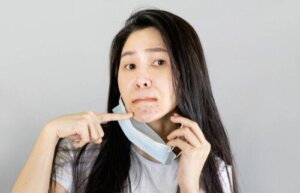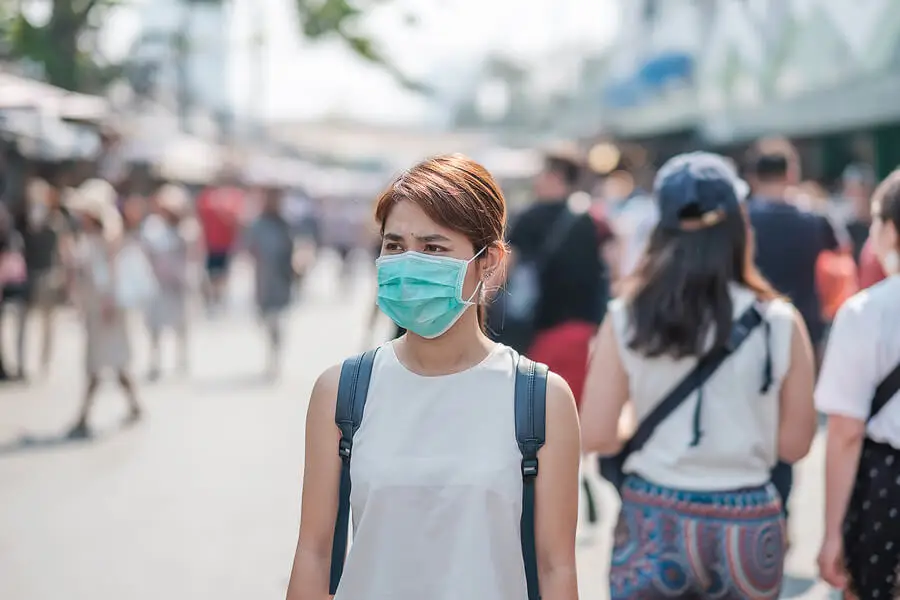Maskne: What Is It and How Can You Avoid It?


Reviewed and approved by the doctor Leonardo Biolatto
Prolonged use of masks may cause maskne. This skin condition shows outbreaks of pimples on the cheeks, nose, and chin. The condition worsens with excess humidity and high temperatures.
Since the beginning of the COVID-19 pandemic, the World Health Organization (WHO) suggested wearing masks during our interaction with other people as a preventive measure. As the peaks of the outbreak diminished, many countries relaxed the requirement to wear a face mask.
However, in nations where it is still the norm and in those who choose to keep the habit, there’s a risk of acne as a side effect. We’ll explain everything you need to know in this article.
What is maskne?
The continuous use of masks is a trigger for acne. The magazine Offarm defines it as a chronic inflammatory condition of the pilosebaceous units of the skin, resulting in the formation of comedones, pustules, and papules.
In the case of maskné, the concept comes from combining the terms mask and acne. The word defines the impurities accumulated in the skin after using masks. It’s more common in a fragile dermis with previous acne and with an oily tendency.
The situation is worsened by the fact of spending a long time without changing masks when you don’t wash the ones made of fabric and the combination with dense makeup. Such aspects promote excessive moisture and the development of bacteria.
In addition, the pores can become irritated by rubbing between the mask fabric and the skin, thus increasing the likelihood of causing small cracks on the face. This weakens the skin barrier.

Symptoms of maskne
The face covered for extended periods of time does not receive enough air and generates more oil, blackheads, and blemishes. In addition, it increases the pH of the skin and changes its temperature.
Mask acne shows pimples, redness, and dryness. The complexion also reflects occlusion pimples, which in turn display pustules and microcomedones.
The areas of eruption are located in the center of the face and the jaw extension. There are other dermatological affectations related to maskne:
- Eczema: The Clínica Universidad de Navarra explains this as a desquamative and itching process. The use of mouth covers is linked to contact eczema.
- Folliculitis: Middlesex Health talks about inflammation of the hair follicles caused by a bacterial or fungal infection. Symptoms are white-headed pimples or tiny red bumps that are capable of transforming into scaly ulcers.
- Seborrheic dermatitis: The journal Dermatología Cosmética, Médica y Quirúrgica describes this skin disease as a chronic, inflammatory, erythematous-squamous process. Its link to masks has to do with the modification of the cutaneous pH and the increase of fat in the face.
We think you may be interested in reading this, too: Treat Acne by Adding 5 Skin Cleansing Shakes to Your Diet
Recommendations to prevent maskne
Acne is annoying and sometimes painful, especially due to friction with the maskne and discomfort due to sweating. This is all in addition to the influence that these obvious lesions on the face generate on our emotional health.
The Mayo Clinic points out that some patients with acne need coping strategies and support since the diagnosis could trigger anxiety and even damage a person’s social relationships and self-esteem.
When it comes to maskne prevention responds to basic recommendations, such as washing hands before touching the face, opting for light creams and gels to protect the skin, and putting on pimple patches so that contact with the mask doesn’t aggravate them. They also suggest more rigorous advice, such as the following.
Change your mask daily
Don’t overextend the useful life of your mask.
The correct thing to do is to wear new or freshly washed masks, as well as to respect the instructions for changing them according to the material they are made of. Disposable masks are not reusable.
Regarding the sanitization of these protective elements, the United Nations newsletter suggests daily washing with detergent or soap and with hot water for fabric masks. Other indications mention that the cleansers strictly have to be mild.
Cleanse your face regularly
The face needs a minimum of two daily washes: once in the morning and once in the evening. You can include light cosmetics to remove dirt, strengthen the skin barrier, and balance the pH.
Soap-free gels with natural ingredients such as orange, tea tree oil, and tangerine extracts are preferable. Always rinse your face with lukewarm water.
It’s also a good idea to create a complete hygiene routine once a week, including exfoliation with beta-hydroxy acids (BAH), emphasizing the area covered by the mask. Deep facial cleansing gets rid of excess sebum and reduces the appearance of pimples.
Moisturize regularly
Moisturizing is necessary to prevent acne by wearing face masks. Consult your dermatologist about a non-comedogenic, fragrance-free moisturizer with sebum-regulating components.
Creams with hyaluronic acid are an option because they restore hydration levels and strengthen the skin. Likewise, lotions with ceramides intervene in the stability and functional capacity of the lipid barrier.
The idea is to apply the moisturizing product half an hour before applying the mask. This is to allow the skin to absorb the substance.
Wear light make-up
Heavy makeup is one of the worst enemies of mask-derived acne. It’s true that you can camouflage imperfections with this beauty tool, but if your skin is weakened, makeup only worsens the condition.
It’s best to avoid high coverage and oily makeup. If possible, discontinue or reduce it until your complexion heals.
Dry pimples and prevents marks
For very inflamed pimples, it is advisable to apply serums with salicylic acid or niacinamide. They contribute to the reduction of swelling and redness. Do not squeeze or pop pimples because of the temptation to drain them; what you will instead produce is more inflammation and a mark.

Protect yourself from the sun
An unavoidable tip to take care of facial skin is to apply sunscreen daily. When the purpose is to prevent maskne, non-comedogenic sunscreens are best.
What type of mask should be used to prevent maskne?
There’s no particular mask that will prevent acne. When choosing, consider factors such as your skin type, the fabric used to make the mask, and whether or not it’s hypoallergenic.
Cotton and silk are recommended materials for sensitive skin.
Masks should fit the face without compressing or occluding it too much. The proper way to know if the mask is beneficial for your skin is to test it for a few days. If you observe any strange reaction, do not hesitate to change it.
On the other hand, the National Institute of Health of Peru urges to be attentive to the lifetime of respiratory protectors, evaluating the state in which they are and discarding them due to dirt, bad treatment, or a bad smell.
Like this article? You may also like to read: 4 Natural Home Remedies to Eliminate Acne Scars
When to visit a dermatologist because of maskne
If the acne outbreak persists after using a mask, rather than venturing with homemade recipes or hiding pimples with makeup, the right thing to do is to visit a dermatologist. The specialist will order treatment according to the severity of the diagnosis.
Medication usually includes creams containing salicylic acid, benzoyl peroxide, retinoids, or tretinoin. If the condition is complicated, antibiotics may also be prescribed.
All cited sources were thoroughly reviewed by our team to ensure their quality, reliability, currency, and validity. The bibliography of this article was considered reliable and of academic or scientific accuracy.
- Acné. Clínica Mayo. Estados Unidos; 2022. https://www.mayoclinic.org/es-es/diseases-conditions/acne/diagnosis-treatment/drc-20368048
- Bernabéu A. Acné. Etiología y tratamiento. Offarm. Vol. 27. Núm. 8. pp. 76-80. España; 2008. https://www.elsevier.es/es-revista-offarm-4-articulo-acne-etiologia-tratamiento-13126071
- Consejos para la población sobre el nuevo coronavirus (2019-nCoV2): cuándo y cómo usar una mascarilla. Organización Mundial de la Salud. 2020. https://www.who.int/es/emergencies/diseases/novel-coronavirus-2019/advice-for-public/when-and-how-to-use-masks
- Covid-19: ¿Qué tipo de mascarilla protege mejor y en cuánto tiempo debes desecharla? Instituto Nacional de Salud. Perú; 2022. https://web.ins.gob.pe/es/prensa/noticia/covid-19-que-tipo-de-mascarilla-protege-mejor-y-en-cuanto-tiempo-debes-desecharla
- Del Pozo A, Martín D. Ceramidas. Offarm. Vol. 23. Núm. 4. pp. 173-174. España; 2004. https://www.elsevier.es/es-revista-offarm-4-articulo-ceramidas-i-conceptos-generales-13061224
- Foliculitis: Middlesex Health. Estados Unidos; 2022. https://middlesexhealth.org/learning-center/espanol/enfermedades-y-afecciones/foliculitis
- Gil Sánchez P. Eccema. Clínica Universidad de Navarra. España. https://www.cun.es/enfermedades-tratamientos/enfermedades/eccema
- La nueva guía de la OMS sobre el uso de mascarillas contra el COVID 19. Noticias ONU. https://news.un.org/es/story/2020/12/1485002
- Medina Castillo E. Dermatitis seborreica: una revisión. Dermatología Cosmética, Médica y Quirúrgica. Vol. 12. Núm. 2. México; 2014. https://www.medigraphic.com/pdfs/cosmetica/dcm-2014/dcm142l.pdf
This text is provided for informational purposes only and does not replace consultation with a professional. If in doubt, consult your specialist.








